Hydraulic Interactions between Injection Events Using Multiple Injection Strategies and a Solenoid Diesel Injector
Abstract
:1. Introduction
2. Methodology
2.1. Experimental Equipment
2.2. Experiments
3. Results and Discussion
3.1. Effect of Dwell Time on the Second Injection Hydraulic Delay
3.2. Effect of Dwell Time on the Second Injection Mass
4. Conclusions
Author Contributions
Funding
Institutional Review Board Statement
Informed Consent Statement
Data Availability Statement
Acknowledgments
Conflicts of Interest
Abbreviations
| DT | Dwell time |
| ET | Energizing time |
| Mass flow rate | |
| p | Pressure |
| SOP | Start of pulse |
| SOI | Start of Injection |
| Subscripts | |
| back | Volume where the fuel is injected |
| f | Fuel |
| rail | Common-rail |
References
- Stoumpos, S.; Theotokatos, G. Multiobjective optimisation of a marine dual fuel engine equipped with exhaust gas recirculation and air bypass systems. Energies 2020, 13, 5021. [Google Scholar] [CrossRef]
- Reksowardojo, I.K.; Setiapraja, H.; Fajar, R.; Wibowo, E.; Kusdiana, D. An Investigation of Laboratory and Road Test of Common Rail Injection Vehicles Fueled with B20 Biodiesel. Energies 2020, 13, 6118. [Google Scholar] [CrossRef]
- Soto, F.; Marques, G.; Soto-Izquierdo, L.; Torres-Jiménez, E.; Quaglia, S.; Guerrero-Villar, F.; Dorado-Vicente, R.; Abdalla, J. Performance and regulated emissions of a medium-duty diesel engine fueled with biofuels from sugarcane over the European steady cycle (ESC). Fuel 2021, 292, 120326. [Google Scholar] [CrossRef]
- Di Blasio, G.; Belgiorno, G. Effects on performances, emissions and particle size distributions of a dual fuel (methane-diesel) light-duty engine varying the compression ratio. Appl. Energy 2017, 204, 726–740. [Google Scholar] [CrossRef]
- Belgiorno, G.; Di Blasio, G.; Shamun, S.; Beatrice, C.; Tunestål, P.; Tunér, M. Performance and emissions of diesel-gasoline-ethanol blends in a light duty compression ignition engine. Fuel 2018, 217, 78–90. [Google Scholar] [CrossRef]
- de la Garza, O.A.; Martínez-Martínez, S.; Avulapati, M.M.; Pos, R.; Megaritis, T.; Ganippa, L. Biofuels and its spray interactions under pilot-main injection strategy. Energy 2021, 219, 119464. [Google Scholar] [CrossRef]
- Karthickeyan, V. Effect of combustion chamber bowl geometry modification on engine performance, combustion and emission characteristics of biodiesel fuelled diesel engine with its energy and exergy analysis. Energy 2019, 176, 830–852. [Google Scholar] [CrossRef]
- Pastor, J.V.; García, A.; Micó, C.; Lewiski, F. Soot reduction for cleaner Compression Ignition Engines through innovative bowl templates. Int. J. Engine Res. 2020, 1–15. [Google Scholar] [CrossRef]
- Monsalve-Serrano, J.; Belgiorno, G.; Di Blasio, G.; Guzmán-Mendoza, M. 1D Simulation and Experimental Analysis on the Effects of the Injection Parameters in Methane–Diesel Dual-Fuel Combustion. Energies 2020, 13, 3734. [Google Scholar] [CrossRef]
- Wang, Q.; Huang, R.; Ni, J.; Chen, Q. Potential Improvement in PM-NOX Trade-Off in a Compression Ignition Engine by n-Octanol Addition and Injection Pressure. Processes 2021, 9, 310. [Google Scholar] [CrossRef]
- Nair, J. Mitigation of Emissions through Injection Strategies for C I Engine. IntechOpen 2021. [Google Scholar] [CrossRef]
- Payri, R.; García-Oliver, J.M.; Mendoza, V.; Viera, A. Analysis of the influence of diesel spray injection on the ignition and soot formation in multiple injection strategy. Energies 2020, 13, 1651. [Google Scholar] [CrossRef]
- D’Ambrosio, S.; Ferrari, A.; Mancarella, A.; Mittica, A. Effects of Rate-Shaped and Multiple Injection Strategies on Pollutant Emissions, Combustion Noise and Fuel Consumption in a Low Compression Ratio Diesel Engine. Int. J. Automot. Technol. 2020, 21, 197–214. [Google Scholar] [CrossRef]
- Chacko, N.; Rajkumar, S.; Thangaraja, J. Experimental and modeling analysis of multiple-injection strategies with B20 operation in a CRDI engine. Fuel 2021, 293, 120433. [Google Scholar] [CrossRef]
- How, H.G.; Masjuki, H.H.; Kalam, M.A.; Teoh, Y.H. Influence of injection timing and split injection strategies on performance, emissions, and combustion characteristics of diesel engine fueled with biodiesel blended fuels. Fuel 2018, 213, 106–114. [Google Scholar] [CrossRef]
- Mei, D.; Yu, Q.; Zhang, Z.; Yue, S.; Tu, L. Effects of Two Pilot Injection on Combustion and Emissions in a PCCI Diesel Engine. Energies 2021, 14, 1651. [Google Scholar] [CrossRef]
- Liang, X.; Liu, Z.; Wang, K.; Wang, X.; Zhu, Z.; Xu, C.; Liu, B. Impact of Pilot Injection on Combustion and Emission Characteristics of a Low-Speed Two-Stroke Marine Diesel Engine. Energies 2021, 14, 417. [Google Scholar] [CrossRef]
- Payri, R.; De la Morena, J.; Pagano, V.; Hussain, A.; Sammut, G.; Smith, L. One-dimensional modeling of the interaction between close-coupled injection events for a ballistic solenoid injector. Int. J. Engine Res. 2019, 20, 452–469. [Google Scholar] [CrossRef]
- Busch, S.; Miles, P.C. Parametric Study of Injection Rates With Solenoid Injectors in an Injection Quantity and Rate Measuring Device. J. Eng. Gas Turbines Power 2015, 137, 1–35. [Google Scholar] [CrossRef]
- Ferrari, A.; Zhang, T. Influence of the injector setup on digital and continuous injection rate-shaping performance in diesel engine passenger cars. Energy Convers. Manag. 2020, 205, 112259. [Google Scholar] [CrossRef]
- Aljohani, B.S.; Ben Houidi, M.; Babayev, R.; Aljohani, K.; Johansson, B. In Situ Injection Rate Measurement to Study Single and Split Injections in a Heavy-Duty Diesel Engine. SAE Tech. Pap. 2019. [Google Scholar] [CrossRef]
- Bosch, W. The fuel rate indicator: A new measuring instrument for display of the characteristics of individual injection. SAE Tech. Pap. 1966. [Google Scholar] [CrossRef]
- López, J.J.; Salvador, F.J.; de la Garza, O.A.; Arrègle, J. A comprehensive study on the effect of cavitation on injection velocity in diesel nozzles. Energy Convers. Manag. 2012, 64, 415–423. [Google Scholar] [CrossRef]
- Ferrari, A.; Mittica, A.; Paolicelli, F.; Pizzo, P. Hydraulic Characterization of Solenoid-actuated Injectors for Diesel Engine Common Rail Systems. Energy Procedia 2016, 101, 878–885. [Google Scholar] [CrossRef]
- Payri, R.; Gimeno, J.; Martí-Aldaraví, P.; Viera, A. Measurements of the mass allocation for multiple injection strategies using the rate of injection and momentum flux signals. Int. J. Engine Res. 2020. [Google Scholar] [CrossRef]
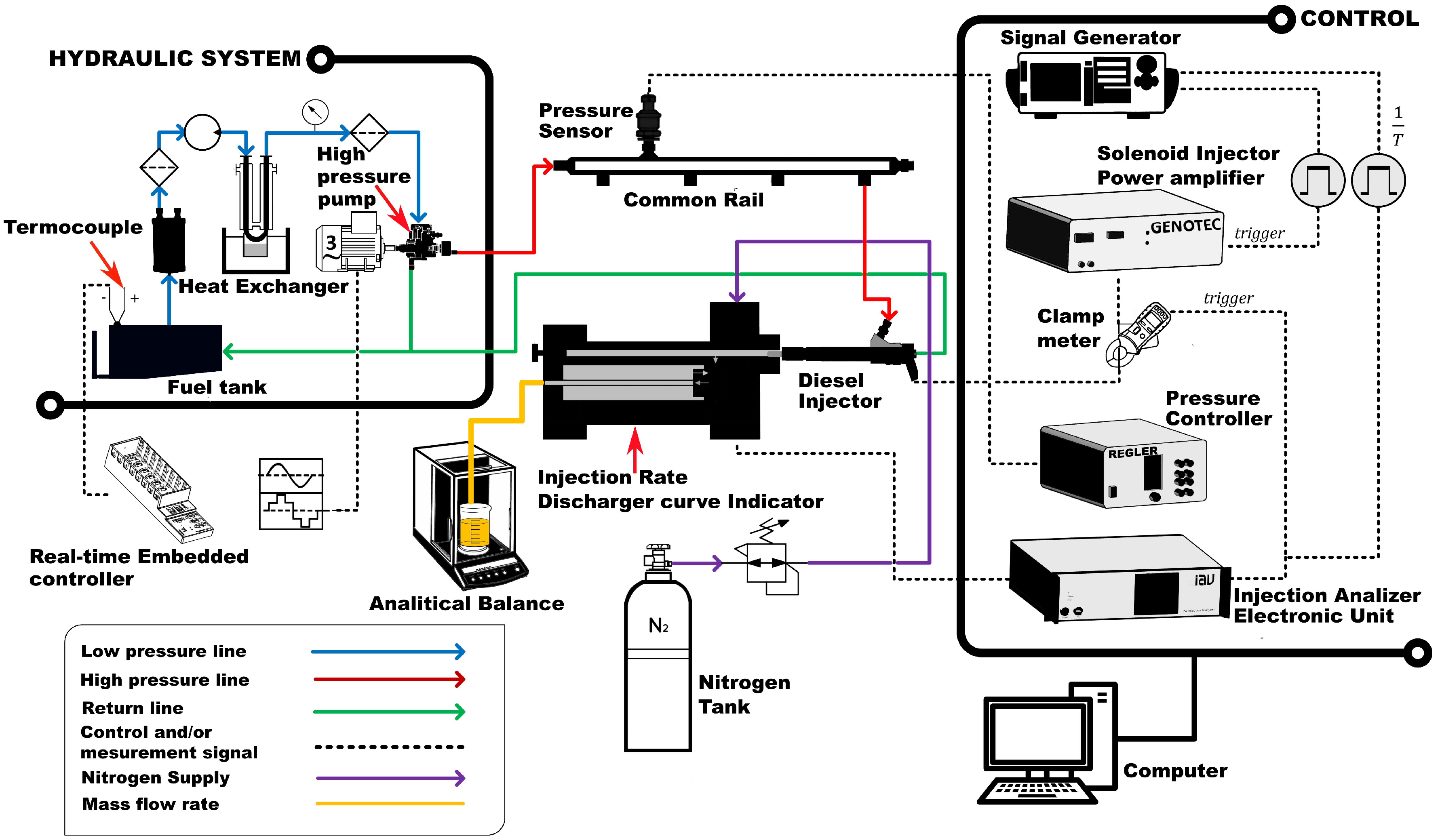

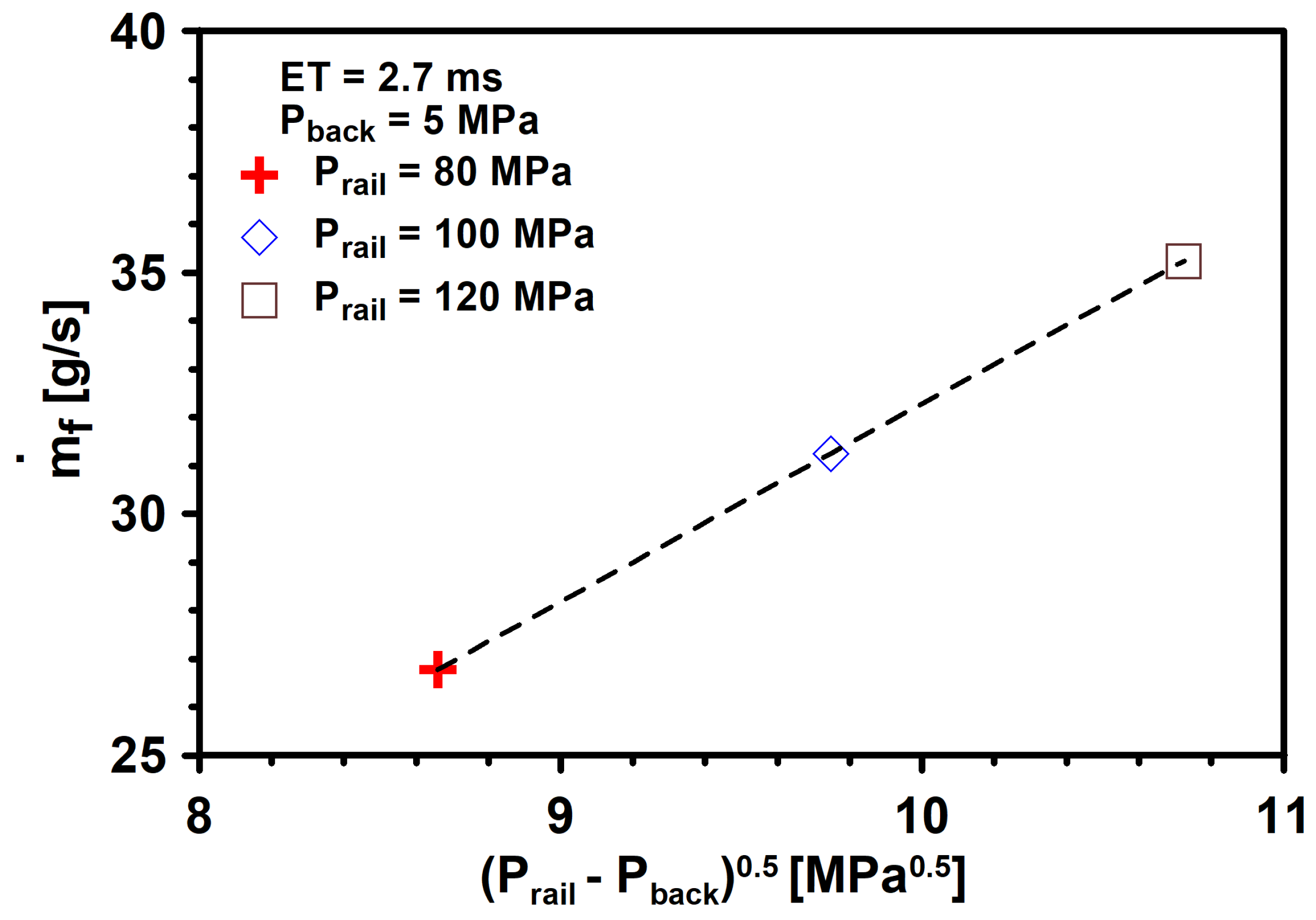
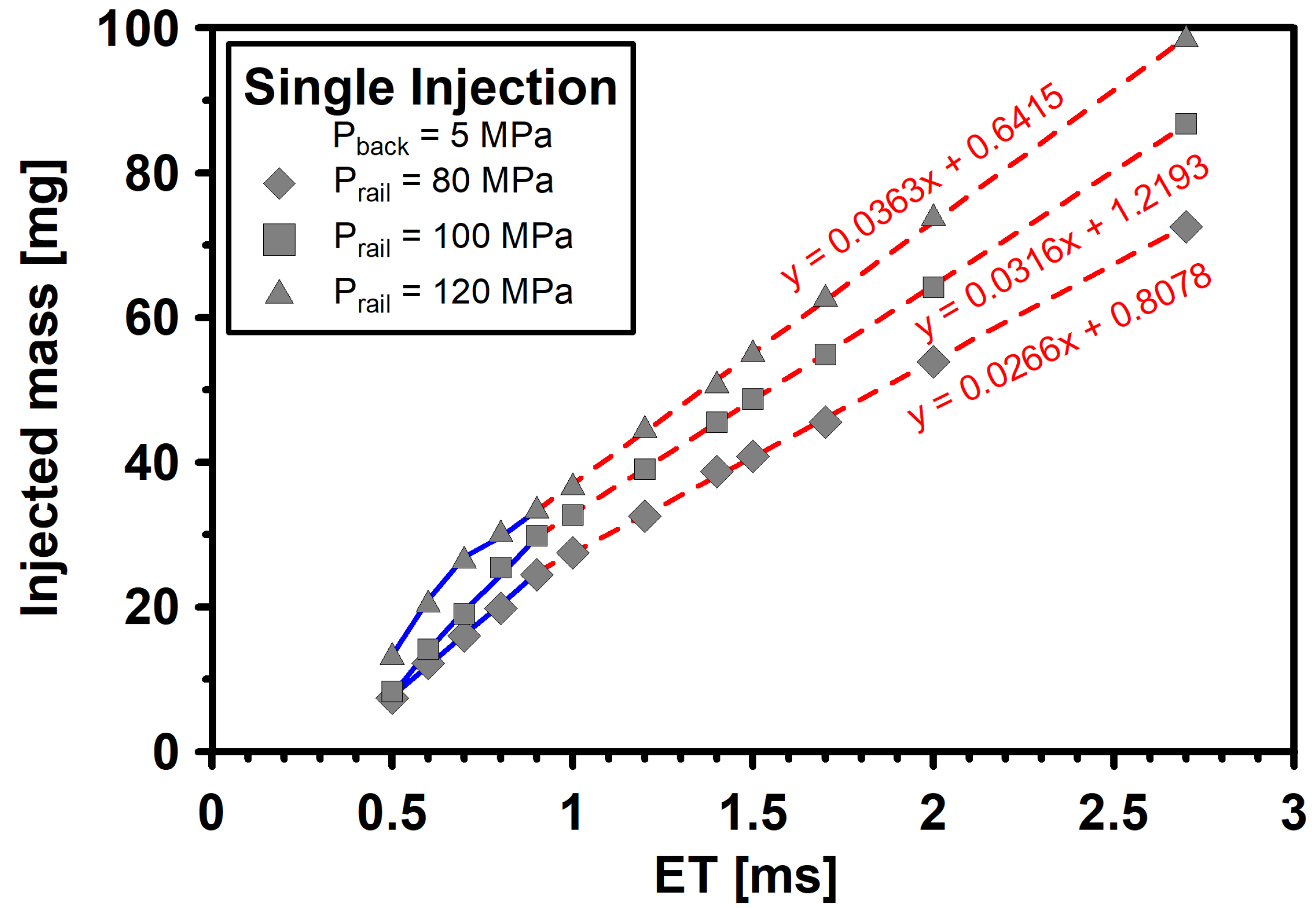

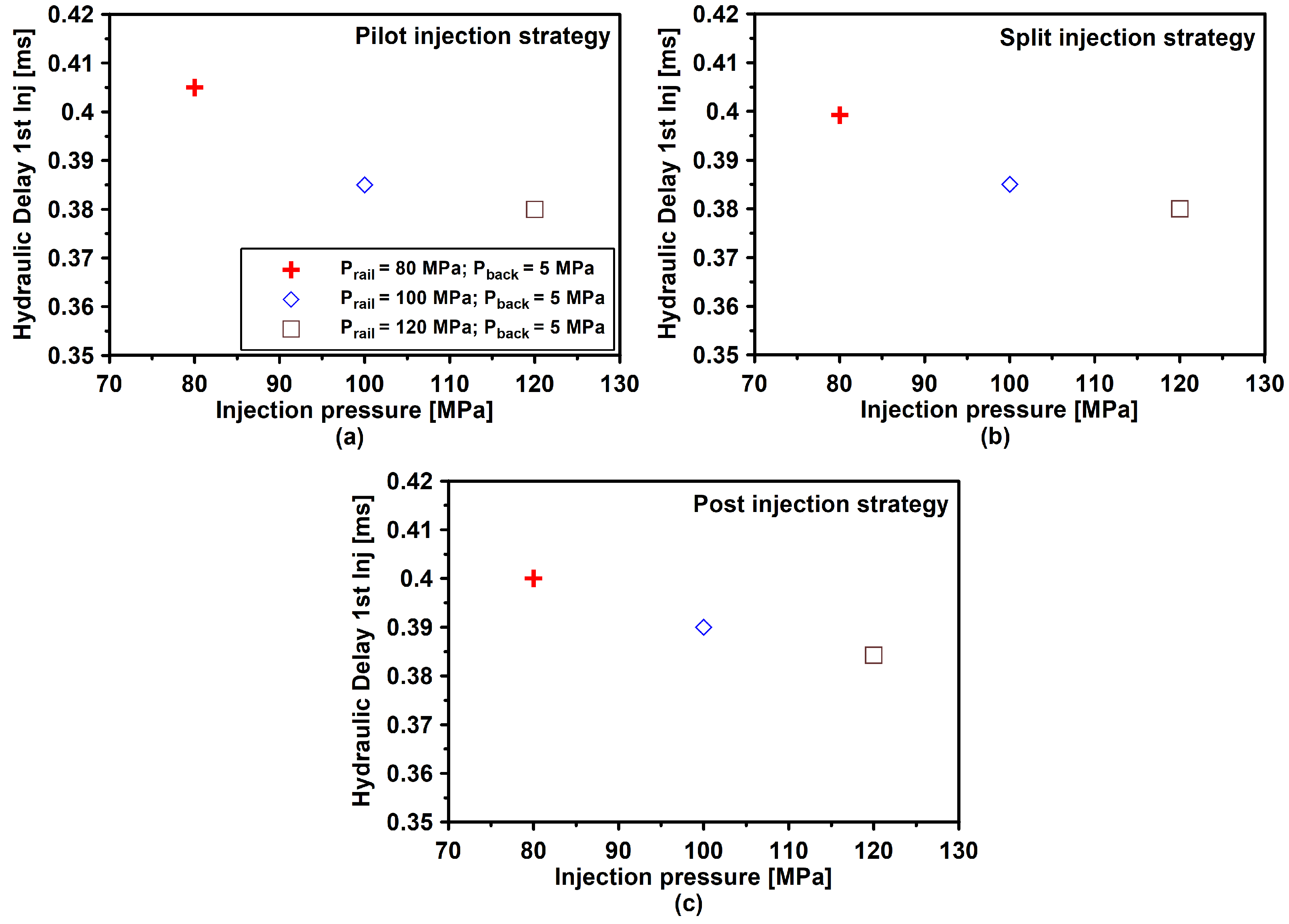
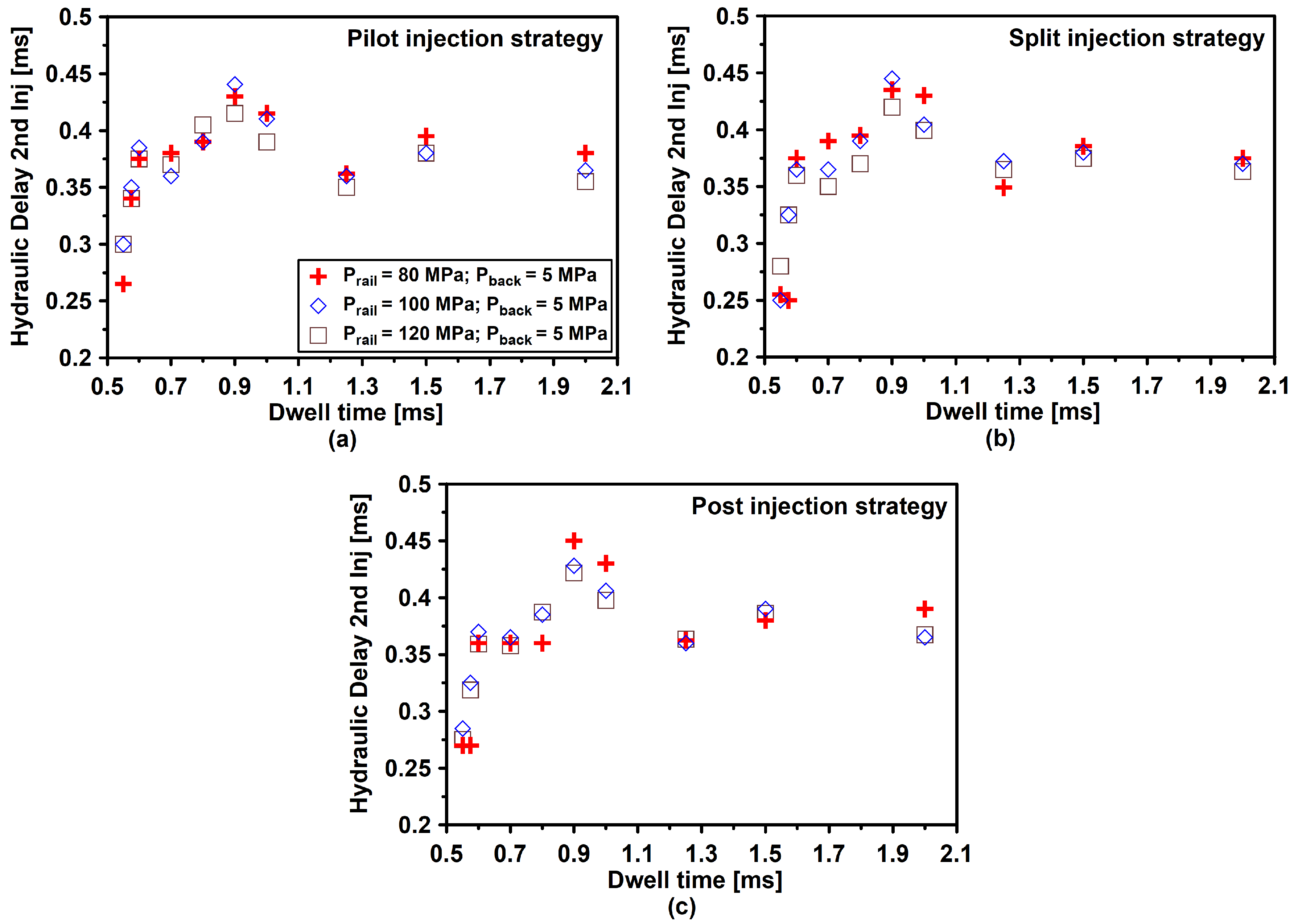
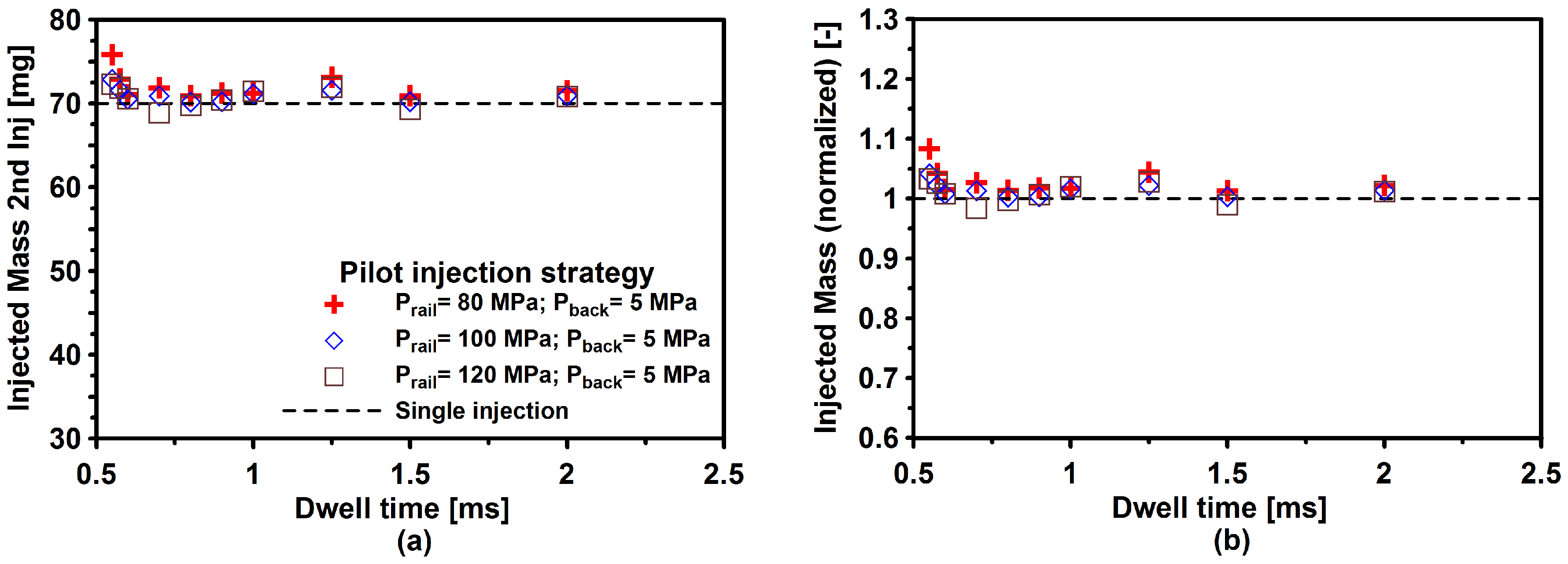
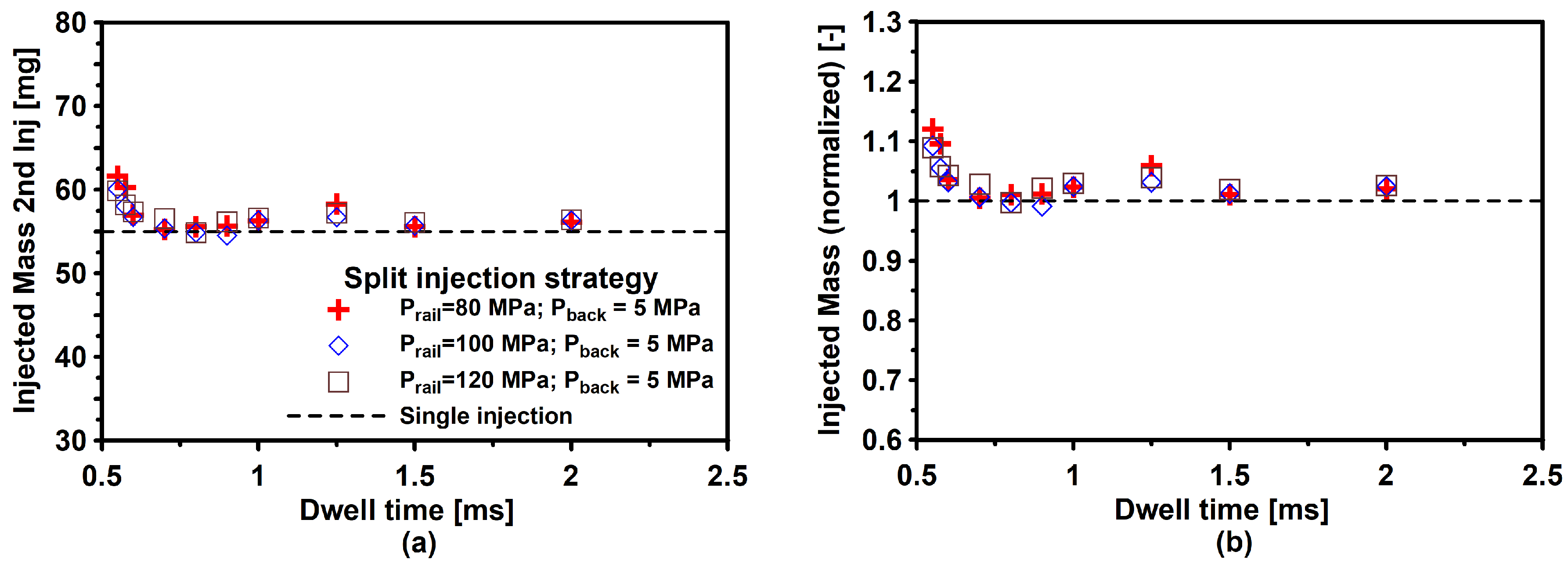
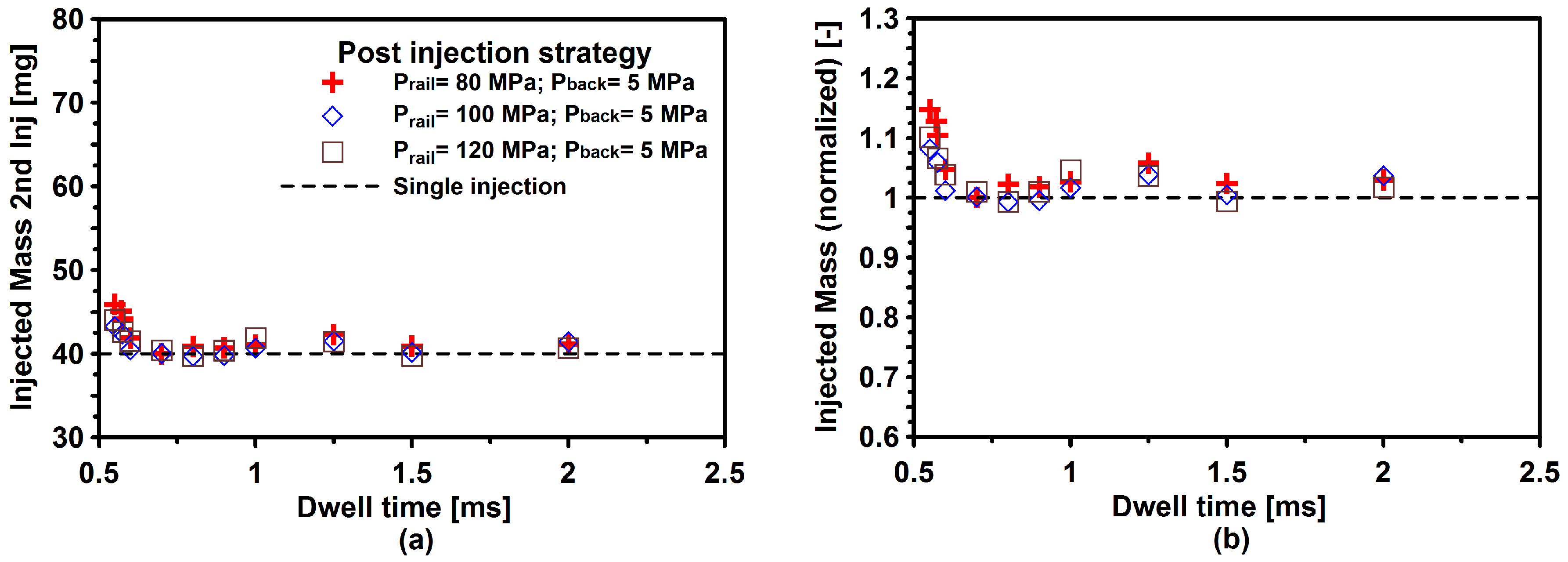
| Parameter | Value |
|---|---|
| [MPa] | |
| [MPa] | |
| Pilot injection strategy | Pilot injection: MPa: 1.473 ms; = 100 MPa: 1.227 ms; = 120 MPa: 1.084 ms. Dwell time: From 0.55 up to 2.0 ms. Main injection: = 80 MPa: 2.601 ms; = 100 MPa: 2.177 ms; = 120 MPa: 1.911 ms. Injected fuel mass: |
| Split injection strategy | First injection: = 80 MPa: 2.037 ms; = 100 MPa: 1.702 ms; = 120 MPa: 1.497 ms. Dwell time: From 0.55 up to 2.0 ms. Second injection: = 80 MPa: 2.037 ms; = 100 MPa: 1.702 ms; MPa: 1.497 ms. Injected fuel mass: |
| Post injection strategy | Main injection: = 80 MPa: 2.601 ms; = 100 MPa: 2.177 ms;
= 120 MPa: 1.911 ms. Dwell time: From 0.55 up to 2.0 ms Post injection: = 80 MPa: 1.473 ms; = 100 MPa: 1.227 ms; = 120 MPa: 1.084 ms. Injected fuel mass: |
Publisher’s Note: MDPI stays neutral with regard to jurisdictional claims in published maps and institutional affiliations. |
© 2021 by the authors. Licensee MDPI, Basel, Switzerland. This article is an open access article distributed under the terms and conditions of the Creative Commons Attribution (CC BY) license (https://creativecommons.org/licenses/by/4.0/).
Share and Cite
Martínez-Martínez, S.; de la Garza, O.A.; García-Yera, M.; Martínez-Carrillo, R.; Sánchez-Cruz, F.A. Hydraulic Interactions between Injection Events Using Multiple Injection Strategies and a Solenoid Diesel Injector. Energies 2021, 14, 3087. https://doi.org/10.3390/en14113087
Martínez-Martínez S, de la Garza OA, García-Yera M, Martínez-Carrillo R, Sánchez-Cruz FA. Hydraulic Interactions between Injection Events Using Multiple Injection Strategies and a Solenoid Diesel Injector. Energies. 2021; 14(11):3087. https://doi.org/10.3390/en14113087
Chicago/Turabian StyleMartínez-Martínez, Simón, Oscar A. de la Garza, Miguel García-Yera, Ricardo Martínez-Carrillo, and Fausto A. Sánchez-Cruz. 2021. "Hydraulic Interactions between Injection Events Using Multiple Injection Strategies and a Solenoid Diesel Injector" Energies 14, no. 11: 3087. https://doi.org/10.3390/en14113087
APA StyleMartínez-Martínez, S., de la Garza, O. A., García-Yera, M., Martínez-Carrillo, R., & Sánchez-Cruz, F. A. (2021). Hydraulic Interactions between Injection Events Using Multiple Injection Strategies and a Solenoid Diesel Injector. Energies, 14(11), 3087. https://doi.org/10.3390/en14113087







